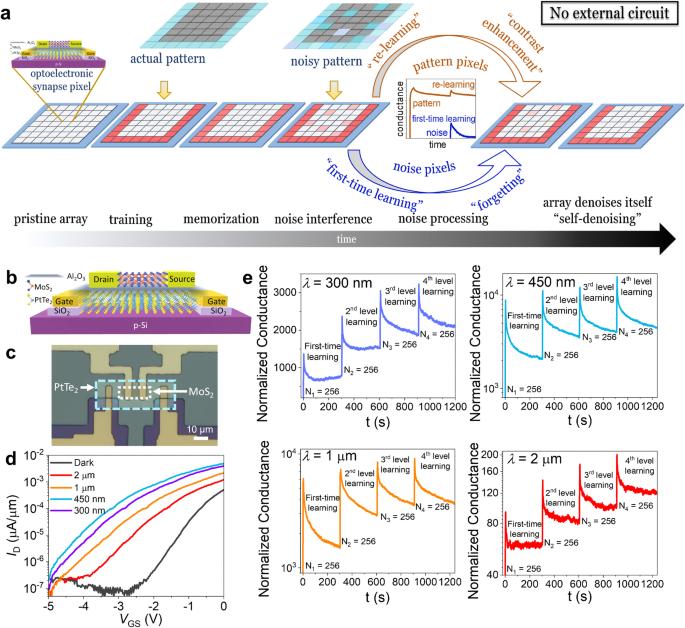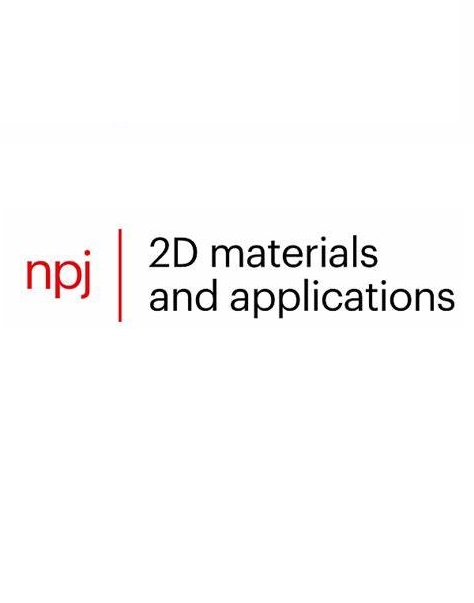融入光电突触阵列的二维材料的生物启发 "自变型 "能力
IF 8.8
2区 材料科学
Q1 MATERIALS SCIENCE, MULTIDISCIPLINARY
引用次数: 0
摘要
在传感器内图像预处理中,传感图像在传感器端进行去噪等低级处理,类似于人眼的视网膜。光电突触设备是实现这一目的以及随后在人工神经网络(ANN)中应用的潜在竞争者。光电突触可在像素本身提供图像预处理功能,即像素内计算。去噪是图像预处理中的一个重要问题,已有多种方法用于对输入图像进行去噪。其中大多数方法需要外部电路,而其他方法只有在噪声像素的强度明显低于实际图案像素时才有效。在这项工作中,我们展示了光电突触阵列的内在能力,一旦经过训练记住了图像,它就能在像素本身进行去噪。突触由带有双层 MoS2 沟道和 p-Si/PtTe2 埋栅极的光电晶体管组成。由于长期电位和短期电位之间的相互作用,我们的 7 × 7 阵列对噪声表现出卓越的鲁棒性。这种生物启发策略无需使用任何外部电路,就能对强度高于记忆模式的噪声进行去噪处理。具体来说,由于这些突触能够对从紫外线 300 纳米到红外线 2 微米的波长做出独特的反应,像素阵列还能对混合色干扰进行去噪。这种人工视觉阵列的 "自我去噪 "能力无需传输原始数据,从而减少了后续图像处理步骤,便于监督学习。本文章由计算机程序翻译,如有差异,请以英文原文为准。

Bio-inspired “Self-denoising” capability of 2D materials incorporated optoelectronic synaptic array
In in-sensor image preprocessing, the sensed image undergoes low level processing like denoising at the sensor end, similar to the retina of human eye. Optoelectronic synapse devices are potential contenders for this purpose, and subsequent applications in artificial neural networks (ANNs). The optoelectronic synapses can offer image pre-processing functionalities at the pixel itself—termed as in-pixel computing. Denoising is an important problem in image preprocessing and several approaches have been used to denoise the input images. While most of those approaches require external circuitry, others are efficient only when the noisy pixels have significantly lower intensity compared to the actual pattern pixels. In this work, we present the innate ability of an optoelectronic synapse array to perform denoising at the pixel itself once it is trained to memorize an image. The synapses consist of phototransistors with bilayer MoS2 channel and p-Si/PtTe2 buried gate electrode. Our 7 × 7 array shows excellent robustness to noise due to the interplay between long-term potentiation and short-term potentiation. This bio-inspired strategy enables denoising of noise with higher intensity than the memorized pattern, without the use of any external circuitry. Specifically, due to the ability of these synapses to respond distinctively to wavelengths from 300 nm in ultraviolet to 2 µm in infrared, the pixel array also denoises mixed-color interferences. The “self-denoising” capability of such an artificial visual array has the capacity to eliminate the need for raw data transmission and thus, reduce subsequent image processing steps for supervised learning.
求助全文
通过发布文献求助,成功后即可免费获取论文全文。
去求助
来源期刊

npj 2D Materials and Applications
Engineering-Mechanics of Materials
CiteScore
14.50
自引率
2.10%
发文量
80
审稿时长
15 weeks
期刊介绍:
npj 2D Materials and Applications publishes papers on the fundamental behavior, synthesis, properties and applications of existing and emerging 2D materials. By selecting papers with the potential for impact, the journal aims to facilitate the transfer of the research of 2D materials into wide-ranging applications.
 求助内容:
求助内容: 应助结果提醒方式:
应助结果提醒方式:


